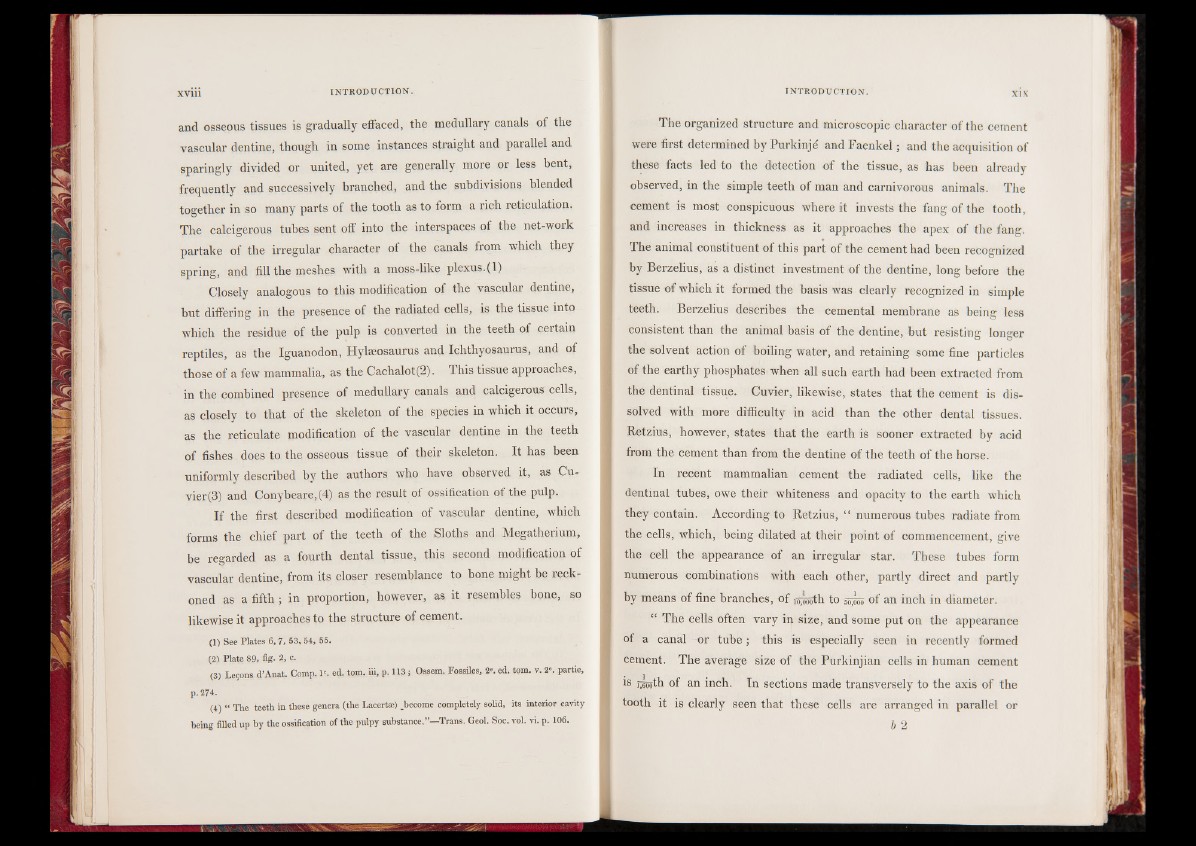
and osseous tissues is gradually effaced, the medullary canals of the
vascular dentine, though in some instances straight and parallel and
sparingly divided or united, yet are generally more or less bent,
frequently and successively branched, and the subdivisions blended
together in so many parts of the tooth as to form a rich reticulation.
The calcigerous tubes sent off into the interspaces of the net-work
partake of the irregular character of the canals from which they
spring, and fill the meshes with a moss-like plexus.(1)
Closely analogous to this modification of the vascular dentine,
hut differing in the presence of the radiated cells, is the tissue into
which the residue of the pulp is converted in the teeth of certain
reptiles, as the Iguanodon, Hylseosaurus and Ichthyosaurus, and of
those of a few mammalia, as the Cachalot(2). This tissue approaches,
in the combined presence of medullary canals and calcigerous cells,
as closely to that of the skeleton of the species in which it occurs,
as the reticulate modification of the vascular dentine in the teeth
of fishes does to the osseous tissue of their skeleton. It has been
uniformly described by the authors who have observed it, as Cuvier
(3) and Conyheare, (4) as the result of ossification of the pulp.
If the first described modification of vascular dentine, which
forms the chief part of the teeth of the Sloths and Megatherium,
be regarded as a fourth dental tissue, this second modification of
vascular dentine, from its closer resemblance to hone might he reckoned
as a fifth ; in proportion, however, as it resembles bone, so
likewise it approaches to the structure of cement.
(1) See Plates 6, 7, 53, 54, 55.
(2) Plate 89, fig- 2, c.
(3) Leçons d’Anat. Comp. 1*. ed. tom. iii, p. 113 ; Ossem. Fossiles, 2*. ed. tom. v. 2'. partie,
p.274.
(4) “ The teeth in these genera (the Lacertæ) ^become completely solid, its interior cavity
being tilled up by the ossification of the pulpy substance.”—Trans. Geol. Soc. vol. vi. p. 106.
The organized structure and microscopic character of the cement
were first determined by Purkinjd and Faenkel; and the acquisition of
these facts led to the detection of the tissue, as has been already
observed, in the simple teeth of man and carnivorous animals. The
cement is most conspicuous where it invests the fang of the tooth,
and increases in thickness as it approaches the apex of the fang.
The animal constituent of this part of the cement had been recognized
by Berzelius, as a distinct investment of the dentine, long before the
tissue of which it formed the basis was clearly recognized in simple
teeth. Berzelius describes the cemental membrane as being less
consistent than the animal basis of the dentine, hut resisting longer
the solvent action of boiling water, and retaining some fine particles
of the earthy phosphates when all such earth had been extracted from
the dentinal tissue. Cuvier, likewise, states that the cement is dissolved
with more difficulty in acid than the other dental tissues.
Retzius, however, states that the earth is sooner extracted by acid
from the cement than from the dentine of the teeth of the horse.
In recent mammalian cement the radiated cells, like the
dentinal tubes, owe their whiteness and opacity to the earth which
they contain. According to Retzius, “ numerous tubes radiate from
the cells, which, being dilated at their point of commencement, give
the cell the appearance of an irregular star. These tubes form
numerous combinations with each other, partly direct and partly
by means of fine branches, of ipsoth to sojm of an inch in diameter.
“ The cells often vary in size, and some put on the appearance
of a canal or tube; this is especially seen in recently formed
cement. The average size of the Purkinjian cells in human cement
is neooth of an inch. In sections made transversely to the axis of the
tooth it is clearly seen that these cells are arranged in parallel or
b 2